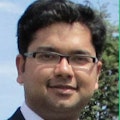Overview
I decided to undertake a PhD following my Masters primerily from a desire to continue the challenges and fulfilment I felt during my undergraduate projects, while also pushing myself to learn new techniques and create new knowledge. I have been always been interested in materials science, and have long played with hobbey AM machines (such as the popular Ultimaker models), so when the opportunity for a research project encapsulating both of these came up I knew it was for me.
As part of my studies I have been able to get familiar with a range of equipment within the School of Engineering including:
-Renishaw AM250 Laser Powder Bed Fusion machine
-DMG Mori Lasertec 40 Laser Milling centre
-Sensofar SMart 3D optical profilometer
-Talysurf tactile profilometer
-Vickers hardness indentors
Very quickly after beginning my PhD studies I joind the PGR Student Staff Panel as the High Value Manfacturing Representative, and subsiquently agreed to chair the pannel for the 2021/2022 session.
As part of my time as a PhD candidate I have assisted with the supervision of multiple 3rd year student projects, and a 4th year Mechatronics group project. These experences have enabled me to grow as a researcher, with a greater understanding of the application of my work, and improved way of communicating my results.
I have also been involved with various undergraduate teaching and demonstration roles, from CAD (Solidworks) and FEA (ANSYS) to Laboritory sessions and design tasks.
Research
Research interests
As part of my work I had to develop a strategy to effectively, and reliably measure the surfaces of AM components for roughness evaluation. This proved to be a very interesting task, with very little existing information available in literature. Using this data I have also been able to benchmark the measurement system and quantify some of the key sources of uncertanty present in my typical measurements.
Likewise, to develop a strategy to smooth the additively manufactured aluminium surfaces of interest, I was essentially starting from zero. While there is a good range of research available, the majority is focussed on Steel or Titanium alloys, with only a handful looking at Aluminium. Compounding this issue, of the available literature looking at laser post-processing Aluminium, only a couple used comparable laser technologies. The process of developing the strategy was very rewarding, during which I came up with further questions that demand their own research.
As part of my work I have presented at the following conferences:
-Speaking of Science (2021) "Confidently uncertain: How wrong are my measurements?". Hosted by the Cardiff University Doctoral Academy I presented a method for quantifying the measurement uncertanties contributed by various data post-processing operations applied.
-1st International Conference on Advanced Manufacturing for Air, Space and Land Transportation (2022) "Laser Polishing of Additively Manufactured Aluminium Surfaces". Hosted by the ESA and NASA, the main content of this presentation was a novel strategy I developed to use Laser Polishing to reduce the surface roughness of AM Aluminium surfaces.
In addition, a paper is under development regarding a practical approach for measuring the surface roughness of Additively Manufactured Aluminium parts.
Teaching
I have been fortunate tobe trusted with the following Teaching / demonstrating roles over the course of my PhD studies. It is always rewarding to help students understand and apply new techniques that can be so fundamental as we progress as engineers
- First Year Solidworks CAD teaching (EN1038)
- Second Year ANSYS FEA teaching (EN2604)
- Second year Laboritory Demonstrating (Heat Treatment of Steel)
I have also been able to assist with a number of 3rd year undergraduate projects around the themes of Additive Manufacture, Laser Polishing, and Surface Profilometry.
Thesis
Evaluation of the interrelation between key process parameters and product/material properties in hybrid additive-subtractive process chains
My research is based around Additive Manufacture of Aluminium (how the manufacturing parameters influence the resulting parts) and Laser post-processing of those parts (how those parameters affect the part). I am workign to establish if there is a link between the desired manufacturing parameters, and post-processing parameters for a given output.
For example, to get the smoothest surface possible, do we want to optimize the manufacturing for the smoothest surface, or allow it to be a little rougher so the laser post-processing has more material to act upon?
The key techniques involved (and that I have been trained to carry out) include:
- Additive Manufacture of Aluminium parts
- Laser Polishing of AM Aluminium parts
- Thermal modelling of the Laser - part interactions
- Tensile Testing
- Hardness Testing
- Mettalographic evaluations
- Surface Roughness Measurements
Funding source
EPSRC


